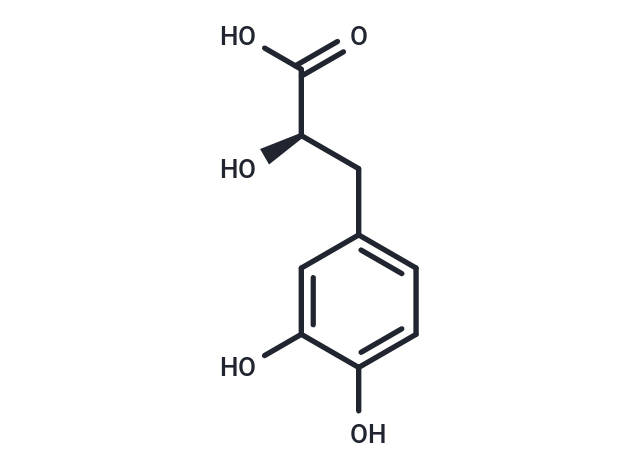Shopping Cart
- Remove All
 Your shopping cart is currently empty
Your shopping cart is currently empty

Danshensu (Dan shen suan A) is an active ingredient of *Salvia miltiorrhiza* with extensive cardiovascular benefits.

| Pack Size | Price | Availability | Quantity |
|---|---|---|---|
| 5 mg | $31 | In Stock | |
| 10 mg | $50 | In Stock | |
| 25 mg | $79 | In Stock | |
| 50 mg | $107 | In Stock | |
| 100 mg | $162 | In Stock | |
| 500 mg | $379 | In Stock |
| Description | Danshensu (Dan shen suan A) is an active ingredient of *Salvia miltiorrhiza* with extensive cardiovascular benefits. |
| In vitro | Danshensu reduces lipid peroxidation on mitochondrial membrane by scavenging free radicals, and inhibits permeability and transmission of mitochondrial membrane by reducing thiol oxidation[1]. Danshensu markedly improves cell viability and decreased lactate dehydrogenase (LDH) release in H9c2 cardiomyocytes. Danshensu increases phosphorylation of Akt and extracellular signal-related kinase 1/2 (ERK1/2) in H9c2 cells, and the protective effects of Danshensu are partially inhibited by phosphatidylinositol 3'-kinase (PI3K) specific inhibitor wortmannin or ERK specific inhibitor U0126. Danshensu could provide significant cardioprotection against MI/R injury, and the potential mechanisms might to suppression of cardiomyocytes apoptosis through activating the PI3K/Akt and ERK1/2 signaling pathways. Danshensu increases Bcl-2 expression and decreases Bax, active caspase-3 expression by activating Akt and ERK signaling pathways. Danshensu has been demonstrated to have biological activities in improving microcirculation, suppressing the formation of reactive oxygen species, inhibiting platelet adhesion and aggregation, protecting myocardium against ischemia, protecting endothelial cells against injury induced by inflammation[2]. |
| In vivo | Pretreatment with danshensu in ISO-administered rats shows a significant (P<0.001) decrease in ST-segment as compared to ISO-administered rats. Its pretreatment also shows significant (P<0.001) decrease in the levels of serum cTnI when compared to the ISO. Thus, danshensu exerts significant cardioprotective effects against ISO-induced myocardial infarction in rats[1]. In the rat model of MI/R injury, Danshensu significantly reduces myocardium infarct size and the production of creatine kinase-MB (CK-MB), cardiac troponin (cTnI) in serum[2]. |
| Kinase Assay | Measurement of inhibitory activities of MG-132 against 20S proteasome: The reaction mixture for the 20S proteasome inhibitory assay contains 0.1 M Tris-acetate, pH 7.0, 20S proteasome, MG-132, and 25 μM substrate dissolved in dimethyl sulfoxide in a final volume of 1 mL. After incuba tion at 37 °C for 15 minutes, the reaction is stopped by the addition of 0.1 mL of 10% SDS and 0.9 mL of 0.1M Tris acetate, pH 9.0. The fluorescence of the reaction products is measured. To determine the IC50 against 20S proteasome, various concentrations of MG-132 are included in the assay mixture. |
| Cell Research | Cardiomyocytes are exposed to ischemia by replacing medium with an 'ischemic buffer', this buffer is designed to simulate the extracellular milieu of myocardial ischemia, with the approximate concentrations of potassium, hydrogen, and lactate ions occurring in vivo. Cells are incubated in the hypoxic/ischemic chamber at 37℃ for 2 h in a humidified atmosphere of 5% CO2 and 95% nitrogen. At the onset of reperfusion, cardiomyocytes are randomly exposed to one of the following treatments: vehicle, Danshensu (1 μM or 10 μM), Danshensu plus the PI3K inhibitor wortmannin (10 nM), Danshensu plus the ERK inhibitor U0126 (10 μM). Simultaneously, in the control group, H9c2 cardiomyocytes are cultured under normal conditions in CO2 incubation. (Only for Reference) |
| Alias | Salvianic acid A, Dan shen suan A |
| Molecular Weight | 198.17 |
| Formula | C9H10O5 |
| Cas No. | 76822-21-4 |
| Smiles | O[C@H](Cc1ccc(O)c(O)c1)C(O)=O |
| Relative Density. | 1.546 g/cm3 |
| Storage | keep away from direct sunlight | Powder: -20°C for 3 years | In solvent: -80°C for 1 year | Shipping with blue ice. | ||||||||||||||||||||||||||||||
| Solubility Information | DMSO: 10 mg/mL (50.46 mM), Sonication is recommended. | ||||||||||||||||||||||||||||||
Solution Preparation Table | |||||||||||||||||||||||||||||||
DMSO
| |||||||||||||||||||||||||||||||

Copyright © 2015-2025 TargetMol Chemicals Inc. All Rights Reserved.